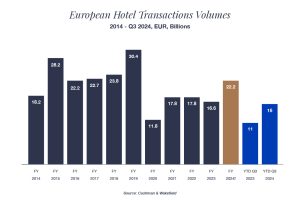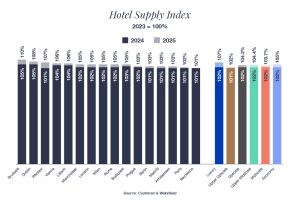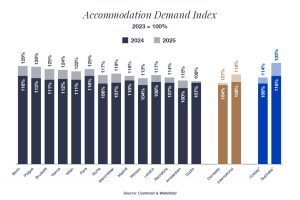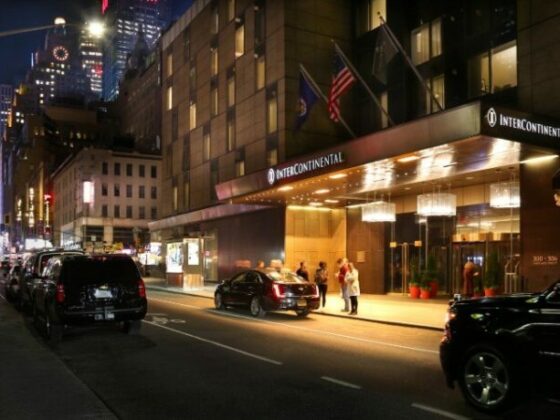International real estate consultancy Cushman & Wakefield has produced its forecast for the European hotel investment market in 2025. We run the rule over the key findings, with expert commentary from C&W’s top hospitality analyst – and friend of The Insider – Bořivoj Vokřínek.
The season of festivities in Europe may be over, with the cold reality of winter still lingering… but for those with their sights on the continent’s hotel real estate assets, the “party has just started”.
That’s the standout headline from the latest hotel sector market report published by the leading real estate consultancy Cushman & Wakefield.
What gives the company’s analysts such cause for optimism? First and foremost, investment activity in the European hotel sector is accelerating, after two years of relatively subdued volumes.

C&W reports that hotel investment transactions in Europe were up by 49% year-on-year in the first half of 2024. And while full-year numbers are still being finalized, the firm expects total investment volumes to hit approximately €22 billion (a 35% year-on-year increase). This year, the forecast is for that number to surpass €25bn. For context, the all-time record annual volume is €30.4bn, achieved in 2019.
One of the prominent features of 2024 was a number of significant portfolio sales to experienced private equity investors. For C&W, this demonstrates “the clear attraction of hotels to capital rich investors who recognize their inherent growth potential and the opportunity to undertake value-add asset management”.
The report notes that “a further boost is expected to come from the return of core institutional capital that has to date remained mostly inactive”, adding that such investors represent an ultimate exit strategy for many value-add and opportunistic players who currently own hotel assets.
Supply growth constrained
If stronger investment demand provides one strand of good news for hotel asset owners, another is the expectation that hotel supply will remain relatively constrained. C&W attributes this to “construction cost inflation, reduced leverage levels and increased debt costs” among other factors.

Even the much-vaunted office-to-hotel conversion trend, exemplified by landmark projects such as Raffles London at the OWO, is predicted to see a slower pace of activity in the coming years as “local planning constraints, recovery of the office sector and the challenging viability of conversions discourage potential schemes”.
Overall supply growth in Europe’s top 15 urban markets is expected to remain moderate, reaching 2.6% in 2025. That said, the luxury segment is poised to outstrip that broader mark with a healthy 4.3% growth in 2025. This includes some significant openings expected throughout the year, such as Chancery Rosewood London, Nobu Lisbon, Mandarin Oriental Vienna and Fairmont Golden Prague.
Bořivoj Vokřínek told The Insider, “The relative strength of luxury supply has both ‘push’ and ‘pull’ factors. In the first instance, it takes a long time to develop luxury hotels, and many of the new properties coming through were actually started before Covid, before being delayed. The Fairmont Golden Prague, in my home city, is a good example.
“From the ‘pull’ side, we’ve all seen the growth of the millionaire class worldwide, and that means healthy demand for luxury travel. In Europe, for example, last year to October we saw the fastest RevPAR growth in the luxury sector, at 7.9% against a sector average of 5.8%. In turn, that is attracting more investors into luxury hotels, particularly high net worth individuals and family offices, who see these assets as a good hedge against inflation.”
Demand begins to “normalize”
One of the big features of the post-pandemic travel and tourism sector was the explosion in so-called ‘revenge travel’ as previously locked down consumers used their new-found freedoms – and pent-up savings – to splash out on holidays.
That snowball has finally stopped rolling, according to C&W, and while the firm says that “there is still some gas left in the tank”, further growth will be “nuanced by market and segment”.

One particularly bright spot is that corporate and group demand – which lagged the post-pandemic recovery in the leisure market – has finally picked up. Indeed, the predicted growth in this segment of almost 15% in 2025 is set to outstrip that of the leisure market.
That said, while business travel is bouncing back, it is doing so in different ways than pre-Covid.
“Part of this bounce-back is due to the release of pent-up demand, as we saw within the leisure segment,” Bořivoj explains. “It’s just that businesses were perhaps more restrained than individuals in when to begin their ‘revenge traveling’. But after relying so much on virtual meetings, we’ve definitely seen a realization of the importance of face-to-face contact – in fact, the forecasts we are seeing now point to corporate demand in 2025 surpassing that of 2019.
“But what I think is perhaps more interesting are the new forms of business travel we are seeing. For example the rise of the ‘super commuter’ who makes use of hybrid working arrangements to live in a different region or even country from where their job is nominally based. We’re also seeing an evolution in executive travel. Where in the past the CEO of an international company might fly regularly but touch down just for a day in a particular location, now they are tending to fly less but will stay in a location for longer – and that means nights in a hotel.”





